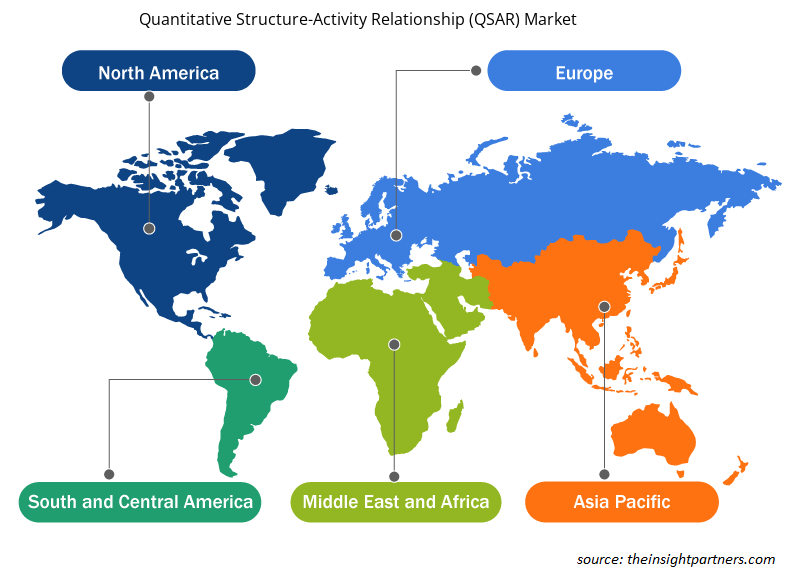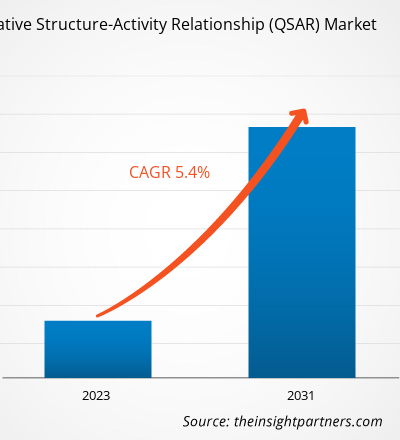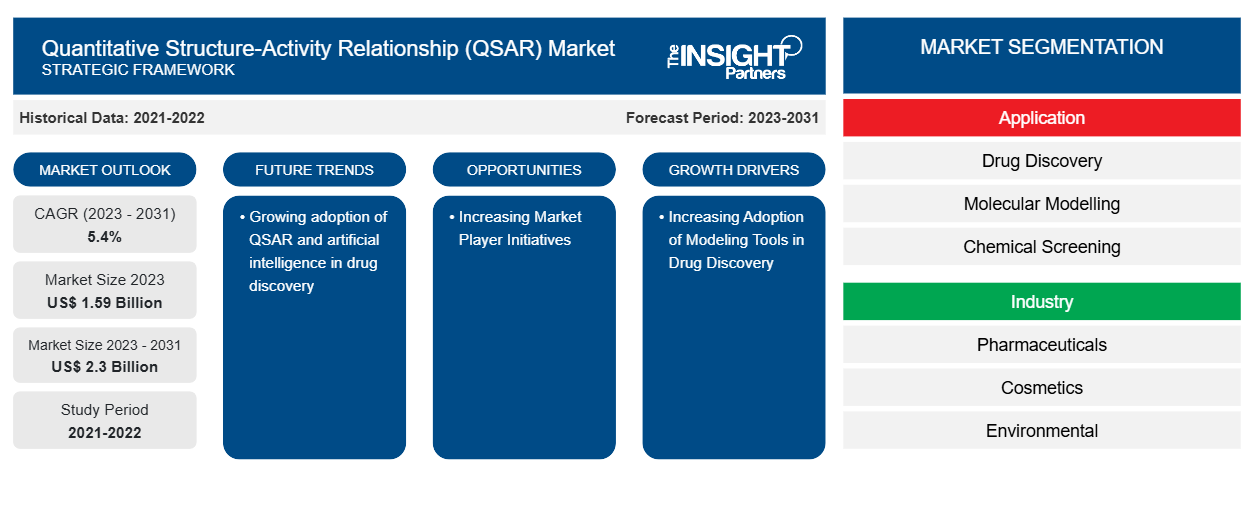양적 구조-활동 관계(QSAR) 시장 규모는 2023년 15억 4천만 달러에서 2031년 23억 달러로 성장할 것으로 예상됩니다. 이 시장은 2023~2031년 연평균 성장률 5.4%를 기록할 것으로 예상됩니다.
약물 발견에 있어 QSAR과 인공지능을 점점 더 많이 도입하는 것이 주요 정량적 구조-활성 관계(QSAR) 시장 동향으로 이어질 가능성이 높습니다.
양적 구조-활동 관계(QSAR) 시장 분석
정량적 구조-활성 관계(QSAR)는 생물학적 활동과 화학 화합물의 구조적 특성 간의 연관성을 밝히기 위한 계산적 또는 수학적 모델링 접근 방식입니다. 통계적 접근 방식을 사용하여 화학 구조와 활동을 상관시키려고 시도합니다. QSAR 모델은 테스트되지 않은 화학 물질의 작용을 예측하는 것을 포함하여 다양한 목적에 유용합니다. 또한, 실리코 방법론으로 원하는 생물학적 활동을 우선 순위를 정하는 데 도움이 되므로 생체 내 실험으로 테스트할 후보 화학 물질의 수가 줄어듭니다. 시장 성장을 주도하는 주요 요인은 약물 발견에서 모델링 도구 채택 증가와 약물 발견의 경제적 부담 증가입니다. 그러나 신흥국에서 이 기술의 채택률이 낮아 시장 성장을 방해합니다.
양적 구조-활동 관계(개요)
북미는 양적 구조-활성 관계에 대한 가장 큰 시장으로, 미국이 가장 큰 시장 점유율을 차지하고 있으며, 그 다음은 캐나다입니다. 이는 연구 개발 활동의 증가, 신생 기업 수의 증가, 희귀 및 불치병 등을 타겟으로 하는 혁신적 약물 후보 개발에 대한 투자 증가에 기인할 수 있습니다. 이 지역 시장 수요는 정부의 의료 인프라 투자, 만성 질환 유병률 증가, 빅데이터 및 건강 IT 도구의 채택 증가와 같은 다른 요인으로 인해 예측 기간 동안 상당한 비율로 성장할 것으로 예상됩니다.
귀하의 요구 사항에 맞게 이 보고서를 사용자 정의하세요
이 보고서의 일부 또는 국가 수준 분석, Excel 데이터 팩을 포함하여 모든 보고서에 대한 사용자 정의를 무료로 받을 수 있으며 신생 기업 및 대학을 위한 훌륭한 혜택과 할인 혜택을 이용할 수 있습니다.
-
이 보고서의 주요 시장 동향을 알아보세요.이 무료 샘플에는 시장 동향부터 추정 및 예측까지 다양한 데이터 분석이 포함됩니다.
양적 구조-활동 관계(QSAR) 시장 동인 및 기회
약물 발견에서 모델링 도구 채택 증가
정량적 구조-활성 관계는 화학 화합물의 구조적 특성과 생물학적 활성 간의 관계를 밝히는 데 사용되는 계산 모델링 방법입니다. 잠재적인 치료적 적용이 있는 약물 발견 및 개발은 복잡하고 비용이 많이 들고 시간이 많이 걸리는 사업으로, QSAR과 같은 다양한 계산 방법론이 약물 발견의 효율성을 높이기 위해 채택되었습니다. 히트 식별에서 리드 최적화에 이르기까지 리간드 또는 구조 기반 가상 스크리닝과 같은 기술은 다양한 제약 회사에서 널리 사용되고 있습니다. 모델링의 도움으로 기존 데이터를 활용하여 제품 안전성 및 효과에 대한 통찰력을 얻을 수 있습니다. 계산 방법의 효율성 덕분에 FDA와 EMA는 효율적인 약물 개발을 달성하기 위해 약물 모델링을 통합했습니다.
시장 참여자 이니셔티브 증가 - 양적 구조-활동 관계(QSAR) 시장의 기회
약물 발견 및 개발에 참여하는 회사들은 발견 일정을 신속히 진행하고 제품 품질을 개선하기 위해 다양한 사업 전략을 채택하고 있습니다. 이 시장의 여러 업체는 혁신적인 바이오텍 회사, 학계, 제약 회사와의 협력에 집중하여 각자의 실리코 기반 서비스 포트폴리오를 강화하고 업계에서 경쟁 우위를 유지하고 있습니다. 대부분의 제약 회사는 모델링 소프트웨어를 채택하여 혜택을 얻었으며, 이는 예측 기간 동안 정량적 구조-활성 관계(QSAR) 시장의 성장을 촉진할 것으로 예상됩니다. 예를 들어, Schrodinger와 Agios Pharmaceuticals, Inc.의 협력은 계산 플랫폼의 도움으로 FDA에서 승인한 두 가지 치료법을 만들어냈습니다.
양적 구조-활동 관계(QSAR) 시장 보고서 세분화 분석
정량적 구조-활성 관계(QSAR) 시장 분석에서 파생된 주요 세그먼트는 질병 및 영상 모달리티입니다.
- 응용 프로그램을 기준으로, 정량적 구조-활성 관계(QSAR) 시장은 약물 발견, 분자 모델링, 화학적 스크리닝, 규제 및 의사 결정, 기타 응용 프로그램으로 세분화됩니다. 약물 발견 부문은 2023년에 더 큰 시장 점유율을 차지했습니다.
- 산업별로, 양적 구조-활성 관계(QSAR) 시장은 제약, 화장품 , 환경, 식품 및 음료로 세분화됩니다. 제약 부문은 2023년에 시장에서 가장 큰 점유율을 차지했습니다.
지역별 양적 구조-활동 관계(QSAR) 시장 점유율 분석
정량적 구조-활성 관계(QSAR) 시장 보고서의 지리적 범위는 주로 북미, 아시아 태평양, 유럽, 중동 및 아프리카, 남미/남중미의 5개 지역으로 나뉩니다.
북미는 양적 구조-활성 관계(QSAR) 시장을 지배해 왔습니다. 미국은 QSAR의 가장 큰 시장입니다. 이 시장의 성장은 주로 약물 발견을 위한 AI의 빠른 통합, 개인화된 의학에 대한 선호도 증가, 새로운 치료적 응용 프로그램을 위한 높은 R&D 지출, 미국 내 주요 시장 참여자의 존재에 의해 주도됩니다. 또한, 약물 개발을 위한 제약 회사와 인공지능 기술 회사 간의 협력 및 파트너십이 증가하면서 시장 성장이 더욱 촉진되었습니다. 나아가 제약 산업에서 인공지능 기술에 대한 인식이 높아지면서 시장에서 다양한 성장 기회가 제공될 것입니다.
양적 구조-활동 관계(QSAR) 시장 뉴스 및 최근 개발
양적 구조-활동 관계(QSAR) 시장은 1차 및 2차 연구 이후의 질적, 양적 데이터를 수집하여 평가합니다. 여기에는 중요한 기업 출판물, 협회 데이터 및 데이터베이스가 포함됩니다. 다음은 언어 장애 및 전략 시장의 개발 목록입니다.
- 크레셋은 화학 빌딩 블록과 약물 발견 서비스의 선도적 공급업체인 에나민과 협력하여 초기 약물 발견 프로세스를 위한 혁신적인 새로운 솔루션을 개발했습니다. (출처: 크레셋, 보도자료, 2024년).
- Royal Free London NHS Foundation Trust는 DeepMind Technologies(Google)와 5년간의 파트너십을 맺었으며, 후자가 전자가 급성 신장 손상에 대한 치료법을 찾는 데 도움이 될 것으로 기대했습니다. 영국의 100,000 Genomes Project라는 국제 프로젝트는 AI와 National Health Service의 흔하지 않은 질병을 앓고 있는 개인의 데이터를 사용합니다. Roche, Merck, Biogen도 이 이니셔티브의 파트너입니다. (출처: DeepMind Technologies, 보도자료, 2020).
양적 구조-활동 관계(QSAR) 시장 지역 통찰력
Insight Partners의 분석가들은 예측 기간 동안 양적 구조-활동 관계(QSAR) 시장에 영향을 미치는 지역적 추세와 요인을 철저히 설명했습니다. 이 섹션에서는 북미, 유럽, 아시아 태평양, 중동 및 아프리카, 남미 및 중미의 양적 구조-활동 관계(QSAR) 시장 세그먼트와 지리적 분포도 논의합니다.

- 양적 구조-활동 관계(QSAR) 시장에 대한 지역별 특정 데이터 얻기
양적 구조-활동 관계(QSAR) 시장 보고서 범위
| 보고서 속성 | 세부 |
|---|---|
| 2023년 시장 규모 | 15억 9천만 달러 |
| 2031년까지 시장 규모 | 23억 달러 |
| 글로벌 CAGR (2023-2031) | 5.4% |
| 역사적 데이터 | 2021-2022 |
| 예측 기간 | 2023-2031 |
| 다루는 세그먼트 |
응용 프로그램으로
|
| 포함된 지역 및 국가 |
북아메리카
|
| 시장 선도 기업 및 주요 회사 프로필 |
|
양적 구조-활동 관계(QSAR) 시장 참여자 밀도: 비즈니스 역학에 미치는 영향 이해
양적 구조-활동 관계(QSAR) 시장 시장은 소비자 선호도의 변화, 기술 발전, 제품의 이점에 대한 인식 증가와 같은 요인으로 인해 최종 사용자 수요가 증가함에 따라 빠르게 성장하고 있습니다. 수요가 증가함에 따라 기업은 제품을 확장하고, 소비자의 요구를 충족하기 위해 혁신하고, 새로운 트렌드를 활용하여 시장 성장을 더욱 촉진하고 있습니다.
시장 참여자 밀도는 특정 시장이나 산업 내에서 운영되는 회사나 기업의 분포를 말합니다. 주어진 시장 공간에 얼마나 많은 경쟁자(시장 참여자)가 존재하는지 그 규모나 전체 시장 가치에 비해 나타냅니다.
양적 구조-활동 관계(QSAR) 시장에서 운영되는 주요 회사는 다음과 같습니다.
- 프로토QSAR SL
- 인터텍 그룹 주식회사
- 다쏘시스템 SE
- 비브라 독성학 자문 및 컨설팅 유한회사
- Laboratory Corporation of America Holdings
- 라담 바이오팜 그룹
면책 조항 : 위에 나열된 회사는 어떤 특별한 순서에 따라 순위가 매겨지지 않았습니다.

- 양적 구조-활동 관계(QSAR) 시장 주요 주요 업체 개요를 알아보세요
양적 구조-활동 관계(QSAR) 시장 보고서 범위 및 제공물
"양적 구조-활동 관계(QSAR) 시장 규모 및 예측(2023-2031)" 보고서는 아래 영역을 포괄하는 시장에 대한 자세한 분석을 제공합니다.
- 범위에 포함된 모든 주요 시장 세그먼트에 대한 글로벌, 지역 및 국가 수준의 시장 규모 및 예측
- 동인, 제약 및 주요 기회와 같은 시장 역학
- 주요 미래 트렌드
- 자세한 PEST/포터의 5가지 힘과 SWOT 분석
- 주요 시장 동향, 주요 업체, 규정 및 최근 시장 동향을 포괄하는 글로벌 및 지역 시장 분석
- 시장 집중도, 히트맵 분석, 유명 기업 및 최근 개발 사항을 포함하는 산업 환경 및 경쟁 분석
- 자세한 회사 프로필
- 과거 분석(2년), 기준 연도, CAGR을 포함한 예측(7년)
- PEST 및 SWOT 분석
- 시장 규모 가치/거래량 - 글로벌, 지역, 국가
- 산업 및 경쟁 환경
- Excel 데이터세트
최근 보고서
사용 후기
구매 이유
- 정보에 기반한 의사 결정
- 시장 역학 이해
- 경쟁 분석
- 고객 인사이트
- 시장 예측
- 위험 완화
- 전략 기획
- 투자 타당성 분석
- 신흥 시장 파악
- 마케팅 전략 강화
- 운영 효율성 향상
- 규제 동향에 발맞춰 대응























 무료 샘플 받기 - 양적 구조-활동 관계(QSAR) 시장
무료 샘플 받기 - 양적 구조-활동 관계(QSAR) 시장